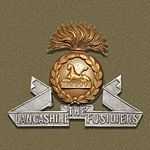Lancashire Fusiliers
| The Lancashire Fusiliers | |
|---|---|
|
Badge of the Lancashire Fusiliers | |
| Active | 1688–1968 |
| Country |
|
| Branch |
|
| Type | Line infantry |
| Role | Fusiliers |
| Garrison/HQ | Wellington Barracks, Bury |
| Nickname |
The Two Tens The Minden Boys Kingsley's Stand |
| Motto | Omnia audax |
| Anniversaries |
Gallipoli (25 April) Minden (1 August) Inkerman (5 November) |
| Insignia | |
| Hackle | Primrose |
The Lancashire Fusiliers was an infantry regiment of the British Army that saw distinguished service through many centuries and wars, including the First and Second world wars. The regiment was amalgamated with other Fusilier regiments in 1968 to form the Royal Regiment of Fusiliers. Some of the Regiments most famous soldiers are Edward Cornwallis, James Wolfe, John Parr, Robert Ross and J. R. R. Tolkien.[1]
17th-19th century
Peyton's Regiment of Foot (1688-1751)
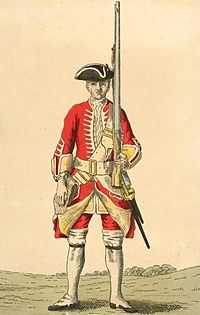
The regiment was formed in 1688 in Devon under Sir Richard Peyton as Peyton's Regiment of Foot. (The regiment's name changed according to the name of the colonel commanding until 1751.) The regiment served in the Glorious Revolution under King William III and at the Battle of the Boyne in July 1690 and Aughrim in 1691. During the War of Spanish Succession (1701–1714), it aided in the capture of Spanish galleons at Battle of Vigo Bay in 1702. The regiment distinguished itself at the Battle of Dettingen in June 1743, and at Fontenoy in May 1745, and served in the Battle of Culloden in April 1746.
20th Regiment of Foot (1751-1782)
In 1751, the regiment became the 20th Regiment of Foot, often written in Roman numerals 'XX Foot', (hence the nickname The Two Tens). During the Seven Years' War the regiment earned honour at the Battle of Minden on 1 August 1759, when, as an infantry formation, they stood up to and broke a French cavalry charge. During the American Revolution the regiment was sent to Quebec in April 1776 and assisted in the relief of Quebec in May 1776. Serving under General John Burgoyne for the remainder of the Canadian campaign, they later surrendered along with General Burgoyne at Saratoga.
East Devonshire Regiment (1782-1881)
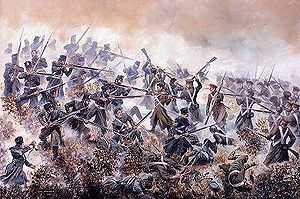
The 20th Regiment of Foot was designated the East Devonshire Regiment in 1782. The 2nd Bn was raised in 1858.[2] During the Napoleonic Wars the 20th Foot fought in several early campaigns before serving with distinction in the Peninsular War, their performance was particularly noted at the Battle of Vittoria where they formed part of the "backbone" of the Duke of Wellington's forces. During the Crimean War, in 1854, they took part in the two major battles of Alma and Inkerman.
Lancashire Fusiliers (1881-1968)
The regiment became the Lancashire Fusiliers in 1881. Under the 1881 Childers Reforms each county regiment had two Militia battalions attached to it: these were found by the 7th Royal Lancashire Militia, raised in 1855 and recruited from Bury, Manchester and Salford. This formed the 3rd and 4th Battalions of the Lancashire Fusiliers. In addition, Rifle Volunteer Corps were attached to their local regiments. In 1883 the 8th Lancashire Rifle Volunteers (raised at Bury on 22 August 1859) became the 1st Volunteer Battalion, Lancashire Fusiliers, and the 12th Lancashire Rifle Volunteers (originally the 24th, raised at Rochdale in February 1860) became the 2nd VB. In 1886 the 56th Lancashire Rifle Volunteers (raised at Salford on 5 March 1860) was transferred from the Manchester Regiment to become the 3rd VB.[3][4]
In common with other regiments recruited from populous urban areas, the Lancashire Fusiliers raised two further regular battalions, the 3rd in 1898, and the 4th in 1900. This necessitated adjustments to the numbers of the Militia battalions. However, the 3rd and 4th Regular battalions were disbanded in 1906.[2]
In 1885 the regiment fought in the Siege of Khartoum in the first Anglo-Sudanese campaign.
During the Second Boer War, in 1899, the 2nd Battalion saw action at the Battle of Spion Kop and also the Fusiliers took part in the Relief of Ladysmith.
Haldane Reforms
Under the Haldane Reforms of 1908, the Militia were redesignated Special Reserve, with the dual wartime role of Home Defence and providing drafts for the Regular Battalions. The Lancashire Fusiliers' militia became 3rd (Reserve) Bn and 4th (Extra Reserve) Bn, both based at Bury. The volunteers now became the Territorial Force (TF), with battalions numbered in sequence after the militia. Thus the 1st VB at Bury became 5th Bn, 2nd VB at Rochdale became the 6th Bn, and the 3rd VB formed the 7th and 8th Bns both based in Salford.[5][6] These four battalions formed the Lancashire Fusiliers Brigade in the East Lancashire Division of the TF on the eve of World War I.[7]
World War I
The Lancashire Fusiliers expanded to over thirty battalions for service in the Great War and would serve with distinction. Eighteen members of the regiment were awarded Victoria Crosses. The regiment was represented in every campaign of the war.
Gallipoli
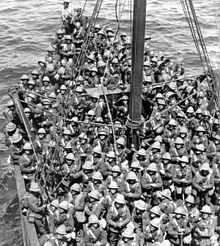
At the initial landings of the Gallipoli Campaign at Cape Helles on 25 April 1915, six Victoria Crosses were awarded to 1st Battalion, Lancashire Fusiliers – 'the six VCs before breakfast'. The landing spot was later known as 'Lancashire Landing'.
Shortly afterwards, the four Territorial battalions from the regiment in 125th (Lancashire Fusiliers) Brigade landed at Helles and took part in the Second Battle of Krithia (6–8 May) under command of the 29th Division. The brigade later rejoined the 42nd (East Lancashire) Division for the Third Battle of Krithia and Battle of Krithia Vineyard.[7]
A subsequent landing further north at Suvla Bay took place on the night of 6/7 August. The Kitchener's Army volunteers of 9th Battalion, Lancashire Fusiliers, part of 34th Brigade of 11th (Northern) Division, waded ashore in deep water and darkness and were pinned down on the beach losing their CO and a number of officers.
A service of commemoration has been held in the regimental town, Bury, every Gallipoli Sunday, the nearest Sunday to 25 April, since 1916. It has recently been decided that this commemoration will continue despite the death of the last survivor of the Lancashire Fusiliers who was present at Gallipoli.
Western Front
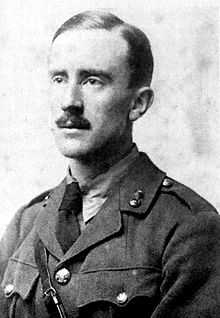
The regiment, like most British regiments in the war, sent the majority of its battalions to the Western Front, in France and Belgium. During the Battle of the Somme in 1916 there were eleven battalions of the regiment that saw action in the campaign including three Pals battalions (including the Accrington Pals) and three Bantam battalions.
The famous fantasy author J. R. R. Tolkien served in this regiment, in the 11th (Service) Battalion, from 1915 until contracting trench fever during the Battle of the Somme in October 1916.
-
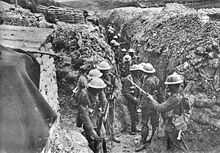
1st Lancashire Fusiliers in a communication trench near Beaumont Hamel, in 1916. Photo by Ernest Brooks
-
_Drummer_and_Bugler.jpg)
5th Bn (TA) Drummer and Bugler
World War II
The Lancashire Fusiliers raised seventeen battalions for service in the Second World War but only a few of them saw active service abroad. The regiment saw service in nearly every theatre of war.
1st Battalion
After recovering its numbers from the First World War the battalion spent the interwar years based in various garrisons around the British Empire. In 1939 the battalion was based in British India. During the Burma Campaign the 1st Battalion fought with various units until 1943 when it became a Chindit formation with the 77th Indian Infantry Brigade which was commanded by Brigadier Orde Wingate and the Chindits were his idea. The battalion was involved in both major Chindit operations, suffering many casualties before the war ended.
2nd Battalion
From the outbreak of war in 1939 to 1940, the 2nd Lancashire Fusiliers served with the 11th Infantry Brigade, part of the 4th Infantry Division, fought in France and Belgium, until being forced to retreat to Dunkirk and withdraw back to Britain, where they stayed until 1942. They then served in the final stages of the North African Campaign, the Tunisia Campaign where the 78th Infantry Division, of whom the 11th Brigade were a part of, gained an excellent reputation, Medjez El Bab, Sicily, and the Italian Campaign (as part of the Gothic Line). During the fighting in Italy Fusilier Frank Jefferson was awarded the Victoria Cross Wallace Jackson, died on Thursday 12 November 2009 aged 89 years. [8] [9] Another well known member of the battalion is C/Sgt Peter Maher MM who now lives in Clitheroe Lancashire.
1/5th Battalion
The 1/5th Battalion was a 1st-Line Territorial Army (TA) Battalion serving in the 42nd (East Lancashire) Infantry Division with the 1/6th and 1/8th battalions in the 125th (Lancashire Fusiliers) Brigade. They were sent to France in 1940 to join the British Expeditionary Force and fought in the Battle of Dunkirk where they were evacuated to Britain. In 1941 the battalion was converted to armour as 108th Regiment Royal Armoured Corps (Lancashire Fusiliers). Units converted in this way continued to wear their infantry cap badge on the black beret of the Royal Armoured Corps.[10]
1/6th Battalion
The 1/6th Battalion served alongside the 1/5th Battalion in France 1940 and were driven back to Dunkirk. In 1941 this 1st-Line TA Battalion was converted, like the 1/5th Battalion, to armour as 109th Regiment Royal Armoured Corps. Units converted in this way continued to wear their infantry cap badge on the black beret of the Royal Armoured Corps[10]
1/8th Battalion
The 1/8th TA battalion began the war in 125th (Lancashire Fusiliers) Brigade with the 1/5th and 1/6th Battalions, but while in France with the British Expeditionary Force it exchanged with the 1st Border Regiment into the 4th Infantry Brigade part of 2nd Infantry Division.[11] During the Battle of France, the 1/8th Lancashire Fusiliers, along with the 2nd Royal Norfolks and the 1st Royal Scots, were overrun on 26–27 May 1940 around the village of Locon, 2 kilometres north of Bethune by advancing German troops. Several massacres of Allied prisoners took place shortly thereafter, such as the Le Paradis massacre, primarily by the German SS Totenkopf Division. Later the battalion fought in the Burma Campaign and participated in many famous battles, such as the Battle of Kohima, serving in the British Fourteenth Army under Bill Slim.
2/5th Battalion
The 2/5th Battalion was part of the 197th Infantry Brigade, once again the 2nd-Line duplicate of the 1st-Line 125th Infantry Brigade.[12] It served with the 66th (East Lancashire) Infantry Division until June 1940 when the division disbanded. The brigade then transferred to the 59th (Staffordshire) Infantry Division (also known as the Pit-head Division). They first saw action in early July 1944 at Malon on North West outskirts of Caen as part of Operation Charnwood. They also took part in Operation Pomegranate and the battles on the Orne River. Of all the companies in this battalion, B Company stood out for the highest number of officers killed (in just two months B Company lost three Commanding Officers, and ALL Officers on a company attack just outside of Vendes). However, by 26 August 1944, the 59th Division was disbanded in order to provide replacements for infantry units, as many had been battered during the Normandy Campaign, and the companies of the 2/5th Battalion were dispatched to different British divisions in the 21st Army Group. The 59th Division was considered by Bernard Montgomery to be one of the best and most reliable divisions in his 21st Army Group and was only chosen for disbandment because it was the youngest British division in France and because of a severe shortage of infantrymen at the time.
2/6th Battalion
Throughout the spring and summer of 1939 the possibility of war with Nazi Germany was becoming increasingly obvious and so the Territorial Army was doubled in size and the 2/6th Battalion, Lancashire Fusiliers came into being as a 2nd Line duplicate of the 1/6th Battalion. Like the 2/5th Battalion, the 2/6th Battalion was also part of 197th Infantry Brigade in the 66th (East Lancashire) Infantry Division and was also transferred to 59th (Staffordshire) Infantry Division after 66th Division disbanded. However, in October 1942 the 2/6th Battalion was transferred elsewhere when it was replaced in the 197th Brigade by the 1/7th Battalion, Royal Warwickshire Regiment. The 2/6th Battalion remained in the United Kingdom throughout the war.[13]
2/8th Battalion
This 2nd-Line TA Battalion was formed as a duplicate of the 1/8th Battalion and began the war in the 199th Infantry Brigade, part of 66th (East Lancashire) Infantry Division and later transferred to the 55th (West Lancashire) Infantry Division when the 66th Division was disbanded in July 1940. It did not leave the United Kingdom and was disbanded in October 1944.[14]
7th Battalion
In 1936 this TA battalion was converted into 39th (The Lancashire Fusiliers) Searchlight Regiment, Royal Engineers, based in Salford. In the summer of 1940, while serving in 53 Anti-Aircraft Brigade, covering the North Midlands, it was transferred to the Royal Artillery. In May 1943 it converted back to infantry as 7th Lancashire Fusiliers[15][16]
9th Battalion
The 9th Battalion, Lancashire Fusiliers was a hostilities-only battalion raised in 1940[2] and was assigned to the 208th Independent Infantry Brigade (Home) before being reassigned to the 125th Infantry Brigade, 42nd (East Lancashire) Infantry Division, alongside the 1/5th and 1/6th battalions of the Lancashire Fusiliers. In 1941 the 9th Battalion was converted to armour as 143rd Regiment Royal Armoured Corps.[10] However, the regiment was disbanded in 1943 and many of its men volunteered to join the Parachute Regiment or were sent to other British tank units.
10th Battalion
This battalion was raised in 1940[2] and served for a year in 208th Independent Infantry Brigade (Home).[17] In 1942 it was shipped to India and fought in the Arakan Campaign 1942-1943 as part of 7th Indian Infantry Division.[18] The battalion was disbanded on 31 October 1945.
11th Battalion
The 11th Battalion was a hostilities-only battalion raised in 1940[2] and served in the garrison of Malta during the Siege with the 233rd Infantry Brigade.[19] In August 1944 it transferred to the 66th Infantry Brigade of the 1st Infantry Division which was serving in the in Italian Campaign, where it took part in the fighting on the Gothic Line. Early in 1945 the 11th Battalion was transferred to Palestine with the rest of the 1st Infantry Division and remained there for the rest of the war.[20]
Battle honours
- Dettingen, Minden, Egmont-op-Zee, Egypt, Maida, Vimiera, Corunna, Vittoria, Pyrenees, Orthes, Toulouse, Peninsula, Alma, Inkerman, Sevastopol, Lucknow, Khartoum, Relief of Ladysmith, South Africa 1899-1902
- Great War (30 Battalions): Le Cateau, Retreat from Mons, Marne 1914, Aisne 1914 '18, Armentières 1914, Ypres 1915 '17 '18, St. Julien, Bellewaarde, Somme 1916 '18, Albert 1916 '18, Bazentin, Delville Wood, Pozières, Ginchy, Flers-Courcelette, Morval, Thiepval, Le Transloy, Ancre Heights, Ancre 1916 '18, Arras 1917 '18, Scarpe 1917 '18, Arleux, Messines 1917, Pilckem, Langemarck 1917, Menin Road, Polygon Wood, Broodseinde, Poelcappelle, Passchendaele, Cambrai 1917 '18, St. Quentin, Bapaume 1918, Rosières, Lys, Estaires, Hazebrouck, Bailleul, Kemmel, Béthune, Scherpenberg, Amiens, Drocourt-Quéant, Hindenburg Line, Épéhy, Canal du Nord, St. Quentin Canal, Courtrai, Selle, Sambre, France and Flanders 1914–18, Doiran 1917, Macedonia 1915–18, Helles, Landing at Helles, Krithia, Suvla, Landing at Suvla, Scimitar Hill, Gallipoli 1915, Rumani, Egypt 1915–17
- Second World War: Defence of Escaut, St. Omer-La Bassée, Caen, North-West Europe 1940 '44, Medjez el Bab, Oued Zarga, North Africa 1942–43, Adrano, Sicily 1943, Termoli, Trigno, Sangro, Cassino II, Trasimene Line, Monte Ceco, Monte Spaduro, Senio, Argenta Gap, Italy 1943–45, Malta 1941–42, Rathedaung, Htizwe, Kohima, Naga Village, Chindits 1944, Burma 1943–45
Victoria Cross recipients
The following members of the Regiment were awarded the Victoria Cross:
- Captain (Temporary Major) Cuthbert Bromley, Great War
- Serjeant Frank Edward Stubbs, Great War
- Lance-Corporal (later Lieutenant-Colonel) John Elisha Grimshaw, Great War
- Captain (later Major) Richard Raymond Willis, Great War
- Serjeant Alfred Joseph Richards, Great War
- Private (later Lance-Sergeant) William Stephen Keneally, Great War
- Private John Lynn, Great War
- Private (later Corporal) James Hutchinson, Great War
- Captain (Temporary Lieutenant-Colonel) Bertram Best-Dunkley, Great War
- Serjeant Joseph Lister, Great War
- Second Lieutenant Bernard Matthew Cassidy, Great War
- Temporary Second Lieutenant John Schofield, Great War
- Lance-Corporal Joel Halliwell, Great War
- Lance-Sergeant (later Lieutenant) Edward Benn Smith, Great War
- Acting Sergeant Harold John Colley, Great War
- Private Frank Lester, Great War
- Sergeant (later Regimental Sergeant-Major) James Clarke, Great War
- Acting Lieutenant-Colonel James Neville Marshall, Great War
- Fusilier (later Lance-Corporal) Francis Arthur Jefferson, Second World War
Football
The football team of the 1st Battalion was a member of the Irish Football League for the 1891-92 season, while deployed in Victoria Barracks, Belfast, and won the Army Cup in 1896-97 while deployed to Athlone.[21][22][23]
Notes
- ↑ 20th Regiment - Regimental History
- ↑ 2.0 2.1 2.2 2.3 2.4 Regiments.org: Lancashire Fusiliers
- ↑ Lancashire Record Office Handlist 72
- ↑ Monthly Army List 1881–1908.
- ↑ The Long, Long Trail: Lancashire Fusiliers
- ↑ The Regimental Warpath: Lancashire Fusiliers
- ↑ 7.0 7.1 Becke, pp. 35–41.
- ↑ The Lancashire Fusiliers homepage, 6 April 2014.
- ↑ The Westmorland Gazette, November 12 2009.
- ↑ 10.0 10.1 10.2 Forty, pp. 50–1.
- ↑ Joslen, pp. 234, 310.
- ↑ Joslen, p. 361.
- ↑ name = Joslen361
- ↑ Joslen, p. 363.
- ↑ http://www.ra39-45.pwp.blueyonder.co.uk/sl/page19.html
- ↑ http://www.ra39-45.pwp.blueyonder.co.uk/home/page51.html
- ↑ Joslen, p. 371.
- ↑ Joslen, p. 537.
- ↑ Joslen, p. 395.
- ↑ Joslen, p. 298.
- ↑ Northern Ireland - Final League Tables 1890-1998
- ↑ Regiments.org (Accessed 4 March 2015)
- ↑ Ireland's Saturday Night, 1 May 1897
References
- History of the XX Regiment
- 20th Regiment - Regimental History
- Maj A.F. Becke,History of the Great War: Order of Battle of Divisions, Part 2a: the Territorial Force Mounted Divisions and the 1st-Line Territoral Force Divisions (42–56), London: HM Stationery Office, 1935/Uckfield: Naval & Military Press, 2007, ISBN 1-84734-739-8.
- Forty, George (1998). British Army Handbook 1939–1945. Stroud: Sutton Publishing. ISBN 0-7509-1403-3.
- Lt-Col H.F. Joslen, Orders of Battle, United Kingdom and Colonial Formations and Units in the Second World War, 1939–1945, London: HM Stationery Office, 1960/Uckfield: Naval & Military, 2003, ISBN 1-84342-474-6.
- Latter, J.C. (1949). The History of the Lancashire Fusiliers 1914–1918, 2 volumes. Aldershot: Gale & Polden.
- Moorhouse, G. (1992). Hell's Foundations: A Town, its Myths and Gallipoli. London: Hodder & Stoughton. ISBN 0-340-43044-3.
External links
| Wikimedia Commons has media related to Lancashire Fusiliers. |
- Regimental museum
- Website for ex-members of the regiment
- The British Army– The Twentieth of Foot
- British Regimental Drums & Colours
- Regiments.org: Land Forces of Britain, the Empire and Commonwealth
- The Regimental Warpath 1914–1918
- The Long, Long Trail
- The Royal Artillery 1939–1945
| ||||||||||||||||||
